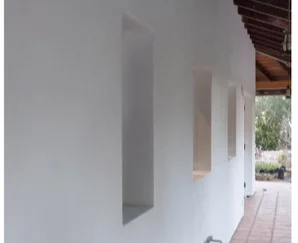“If you want to stay warm, you wear your sweater on the outside. You don’t eat it.” - Dr. Joe Lstiburek
Beginning January 1, 2020, the newest update to the California Building Code will take effect. For architects and builders, a significant change toward better performance of buildings and reduction of energy loads will be the inclusion of continuous exterior wall insulation on almost all new homes and buildings.
Though often seen as a nuisance, exterior wall insulation - EWI or EIFS, an exterior insulation finishing system - provides benefits surpassing cavity-insulation alone. In addition to sound attenuation and thermal comfort, the primary benefits of EWI are added thermal mass and mitigated thermal bridging - what occurs when a building material, often structural, passes continuously through the insulation layer from the exterior to the interior of a building.
In a typical home, an R6.5 stud within a wall of R19 insulation represents not merely a thermal bridge but a thermal super-highway. The differences in heat conductivity between these materials can lead not only to discomfort, but also condensation, mold, and mildew growth within walls. EWI, often in the form of rigid boards or high-compression batts, works as a roadblock against these thermal bridges and highways.
In addition to improving energy performance, insulation materials give us great opportunities to reduce a building’s embodied-carbon footprint. Common EWI products include rigid woodfiber boards (such as Gutex), mineral-wool batts (such at Rockwool) and EPS (expanded polystyrene) or XPS (extruded polystyrene) foam boards.
Installing Gutex woodfiber boards.
Gutex boards offer a simple, carbon-neutral material. The 2’x4’ boards have thicknesses ranging from 1.5” – 4.75” with R-values ranging from R5.8 to R17. Some manufacturers offer product lines with inherent rainscreen capabilities, while others require membrane coverage and/or use a lime-plaster stucco finishing system.
Rockwool batt installation with furring strips for future vented cladding.
Mineral-wool batts like Rockwool are often accompanied by furring strips and vented siding or cladding. The embodied carbon footprint is generally higher than woodfiber boards. It is inherently non-combustible and rot resistant.
An advantage of Gutex or Rockwool-type products as an EWI is their high vapor permeability and inherent drying capacity. After all, it’s not if your walls will get wet, but when. Rather than retaining vapor and moisture while offering food for mold and mildew, these materials will instead release moisture and dry out, thereby maintaining their thermal resistance capacities.
EPS (expanded polystyrene) and XPS (extruded polystyrene) foam boards are perhaps the most well-known EWI materials, however we encourage limited use of rigid foam products on buildings where not necessary. Foam insulation materials, being vapor-closed without drying capacity, require careful attention to the sequencing of wall construction to prevent moisture traps, growth of mold, and failure of assemblies. Why go down that highway when safer, easier options exist?
Finished exterior wall insulation with Gutex and lime-plaster stucco.
All rigid boards and mineral-wool batts are attached to wood sheathing and masonry with a screw-and-washer fastener. And while EWI has performance benefits, a challenge for architects and builders is to create new drainage measures. Work within a manufacturer’s waterproofing system. Locate your membranes to prevent air-leakage. And avoid moisture traps to ensure your assembly’s performance and longevity..
Wear your sweater on the outside. Don’t eat it!




